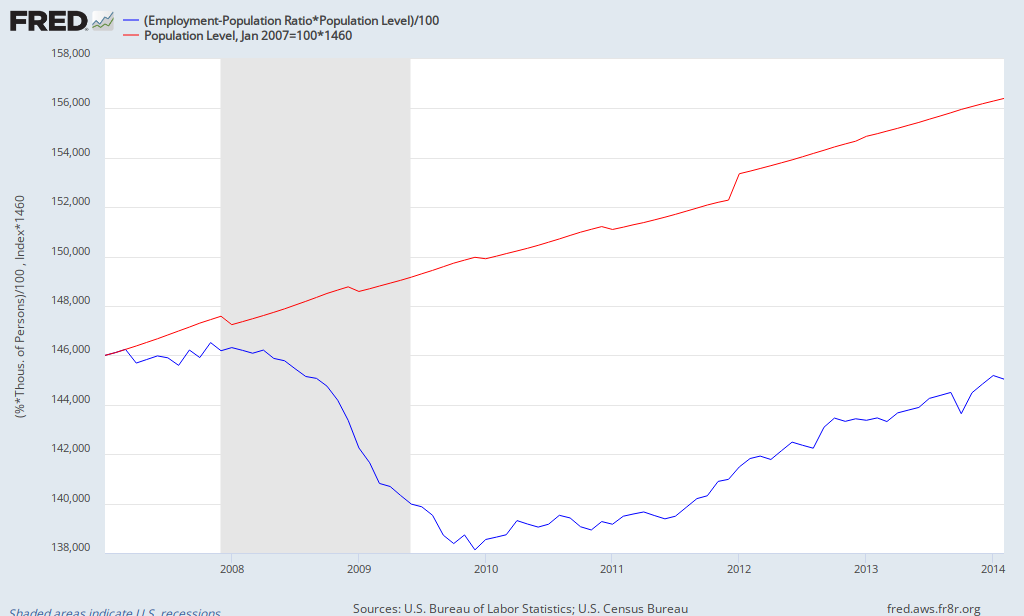Written by Steven Hansen
A post The Vast Majority of the 5.8 Million Missing Workers Are Under Age 55 got me thinking. This post uses participation rates, and contrary to popular opinion shows the majority of missing workers from the workforce are under 55 years old. This post can be summed up with their graph:

[click on the above graph to enlarge]
There is no disagreement with the premise that the vast majority of the “missing” workers are under age 55. The problem is calculating how many people are missing. As an analyst, I have no employment data which I believe is accurate. Let us look at the BLS definitions:
Employed: Persons 16 years and over in the civilian noninstitutional population who, during the reference week, (a) did any work at all (at least 1 hour) as paid employees; worked in their own business, profession, or on their own farm, or worked 15 hours or more as unpaid workers in an enterprise operated by a member of the family; and (b) all those who were not working but who had jobs or businesses from which they were temporarily absent because of vacation, illness, bad weather, childcare problems, maternity or paternity leave, labor-management dispute, job training, or other family or personal reasons, whether or not they were paid for the time off or were seeking other jobs. Each employed person is counted only once, even if he or she holds more than one job. Excluded are persons whose only activity consisted of work around their own house (painting, repairing, or own home housework) or volunteer work for religious, charitable, and other organizations.
Unemployed: Persons aged 16 years and older who had no employment during the reference week, were available for work, except for temporary illness, and had made specific efforts to find employment sometime during the 4-week period ending with the reference week. Persons who were waiting to be recalled to a job from which they had been laid off need not have been looking for work to be classified as unemployed.
Labor Force: The labor force includes all persons classified as employed or unemployed in accordance with the definitions contained in this glossary.
Labor Force Participation Rate: The labor force as a percent of the civilian noninstitutional population.
Who is Employed?
The BLS data has subtle but significant differences depending on what data set you use. Even talking about how many people are employed is different depending on the data set. The following graph highlights the problem.
Civilian Employment (blue line), the Headline Non-Farm Payrolls (red line), Headline Non-Farm Payrolls Used to Guess Total Employed (green line), Employment-Population Ratio times Civilian Noninstitutional Population (orange line covered by the blue line)

First, let us think about the green line in the above graph. Why is this a guess of the total people with jobs? From FRED:
…. Total Nonfarm Payroll is a measure of the number of U.S. workers in the economy that excludes proprietors, private household employees, unpaid volunteers, farm employees, and the unincorporated self-employed. This measure accounts for approximately 80 percent of the workers who contribute to Gross Domestic Product (GDP).
The orange line (covered by the blue line) is also interesting because both are determined by the household survey portion of the job report. The reason I showed both is to demonstrate the methodology used to develop the employment-population ratio.
Where I am going with this post?
I am trying to show that the data is far from definite even when one tries to get information on who actually works. Too many are not being counted, and the same is occurring with unemployment. If this is true, the participation rates are very suspect – and all numbers produced are at best back-of-envelope calculations.
For my “back of envelope” approach, there are a little over 10 million missing from the workforce based on population growth.
Potential Employment Growth based on Growth of Civilian Noninstitutional Population (red line) and Employment-Population Ratio times Civilian Noninstitutional Population (blue line)

Potential jobs growth (red line) was based on growth of employment from January 2007 if jobs had grown at the same rate as population growth. From the graph one can note that this “gap” between potential jobs growth and real jobs growth is barely beginning to close.
The first step in solving a problem is to have accurate data. Employment data is not being collected in a manner which gives one confidence of relevance.
Other Economic News this Week:
The Econintersect Economic Index for March 2014 is showing a moderate growth deceleration. There are soft data points we watch outside of our index which bears watching. Nothing at this time is pointing to real economic contraction, but there is enough data sets in the warning track to let you know that the economy is far from running on all cylinders.
The ECRI WLI growth index value has been weakly in positive territory for over four months – but in a noticeable improvement trend. The index is indicating the economy six month from today will be slightly better than it is today.
Current ECRI WLI Growth Index
/images/z weekly_indexes.PNG
Initial unemployment claims went from 323,000 (reported last week) to 315,000 this week. Historically, claims exceeding 400,000 per week usually occur when employment gains are less than the workforce growth, resulting in an increasing unemployment rate. The real gauge – the 4 week moving average – marginally worsened from 336,750 (reported last week as 336,500) to 330,500. Because of the noise (week-to-week movements from abnormal events AND the backward revisions to previous weeks releases), the 4-week average remains the reliable gauge.
Weekly Initial Unemployment Claims – 4 Week Average – Seasonally Adjusted – 2011 (red line), 2012 (green line), 2013 (blue line), 2014 (orange line)
/images/z unemployment.PNG
Bankruptcies this Week: Privately-held Sbarro










